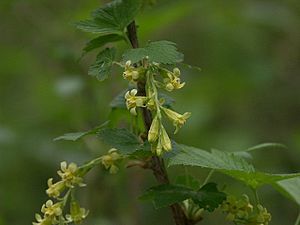Ribes americanum facts for kids
Quick facts for kids Ribes americanum |
|
|---|---|
 |
|
| Conservation status | |
| Scientific classification | |
| Genus: |
Ribes
|
| Species: |
americanum
|
| Synonyms | |
|
List
Coreosma americana (Mill.) Nieuwl.
Ribes campanulatum Moench Ribes floridum L'Hér. Ribes floridum var. grandiflorum Loudon Ribes intermedium Tausch Ribes nigrum var. pennsylvanicum Marshall Ribes recurvatum Michx. Ribes pensylvanicum Lam. |
|
The Ribes americanum, also known as the wild black currant or American black currant, is a cool plant found in North America. It's part of the gooseberry family. You can find this plant growing across a lot of Canada, from Alberta all the way to Nova Scotia. It also grows in the northern United States, from New England to Washington state, and even in Colorado and New Mexico.
Contents
What Does the Wild Black Currant Look Like?
The wild black currant is a shrub that usually grows to be about 0.5 to 1.5 meters (20 to 60 inches) tall. Its branches stand upright, and its leaves fall off in the autumn. Unlike some other plants in its family, this one does not have any sharp spines. Sometimes, many of these plants grow together to form thick patches.
Leaves and Flowers
The leaves are pretty big, up to about 7 to 8 centimeters (3 inches) long. They have 3 or 5 rounded sections, called lobes. In the fall, these leaves turn beautiful shades of red and gold.
The plant's flowers grow in a cluster that hangs down, called a raceme. Each cluster can have up to 15 flowers. The flowers have white or greenish outer parts called sepals, which bend backward. Inside are smaller, whitish petals.
Fruit and Seeds
After the flowers, the plant grows smooth, round, black berries. Each berry is about 1 centimeter (0.4 inches) wide. These berries are safe to eat once they have been cooked. The plant mostly grows new plants from its seeds.
Where Does the Wild Black Currant Grow?
This shrub is native to both the United States and Canada. It can live in many different types of natural areas, called ecosystems. You might find it in various kinds of forests or in wet, spongy areas called conifer bogs.
Different Habitats
In places like Manitoba, it can even be found in marshes. Around the Great Lakes, it grows a lot in meadows filled with sedge plants. The wild black currant can grow on flat plains and in mountains. It can also pop up in places that have been disturbed, like along roadsides. This plant is also good at growing in shady spots, like under the tall trees in thick forests.
It has also been brought to northern China by people.
How Does the Wild Black Currant Interact with Other Living Things?
The flowers of the wild black currant are visited by several types of bees. These bees help the plant by carrying pollen from one flower to another.
Plant Diseases and the Wild Black Currant
This plant can be a host for a plant disease called white pine blister rust. This rust can harm pine trees. Because of this, sometimes wild black currant plants are removed to try and stop the rust from spreading to valuable pine trees.
Another rust, called the cluster cup rust (Puccinia caricina), also affects the leaves of the wild black currant. In the spring, it makes small cup-shaped spots on the leaves. Later, these spots turn into brown patches. This rust then moves to other plants like sedges.
What Are the Uses of Wild Black Currant?
The berries of the wild black currant have been used for a long time. Native Americans used to make a food called pemmican from these berries. Today, the berries are still popular for making tasty jam and jelly.


